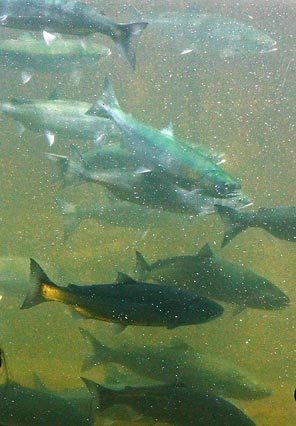forum
library
tutorial
contact

First Sockeye Arrives at
Fish Hatchery near Stanley
by Eric Barker
Lewiston Morning Tribune, July 26, 2008
|
the film forum library tutorial contact |

|
First Sockeye Arrives at
by Eric Barker
|
 The first fish of this year's better-than-normal run of Snake River sockeye returned to the Sawtooth National Fish Hatchery near Stanley on Friday.
The first fish of this year's better-than-normal run of Snake River sockeye returned to the Sawtooth National Fish Hatchery near Stanley on Friday.
Biologists hope many more will follow.
"We are optimistic," said Paul Kline of the Idaho Department of Fish and Game. "We have some pretty good river conditions. It's a little cooler than what we have been seeing (in recent years) and a little higher flows. The conditions are pretty much optimal to get these fish back to the Stanley Basin."
Sockeye have been teetering on the brink of extinction for more than a decade and have been kept from flopping over the edge by a captive breeding program run by Kline. The oceangoing fish that turn bright red while spawning and gave Redfish Lake its name were listed as endangered in 1991. Since then, returns of sockeye above Lower Granite Dam have averaged just 84 fish. But returns of sockeye to their spawning grounds in the Stanley Basin have been in the low single digits most years.
That could change this summer. As of Thursday, 814 sockeye had returned over Lower Granite Dam, 35 miles west of Lewiston on the Snake River. That is about 12 times the 10-year average of 68 and the highest return since Lower Granite Dam was built in 1975.
Kline said that in 2000, the last good year for sockeye, about 80 percent of the fish that were counted crossing Lower Granite made it all the way to the Stanley Basin. But in many years, fewer than 50 percent have made the trip from Lower Granite to the Sawtooth National Fish Hatchery. Last year 52 sockeye were counted at Lower Granite, but just four made it to the Stanley Basin.
Kline believes this year could buck that trend since water temperatures in the Salmon River have stayed cool because of the heavy snowpack and slower than normal spring melt. Those conditions might help depress a pathogen Kline says most of the sockeye appear to be carrying. The department has tested about 40 of the returning sockeye over the past few years and detected the disease in 38 of them. Kline said the pathogen, that can lead to kidney failure, is also found in sockeye that return to the Fraser River in British Columbia.
The disease appears to effect sockeye that stay in fresh water for long periods of time and are exposed to elevated temperatures. That description fits the Snake River run almost perfectly. The fish must make a 900 mile journey from the Pacific Ocean to their spawning grounds during the heat of summer.
"It's a nasty bug, something fish pick up in their juvenile migration," he said. "It's natural in the environment. There is nothing we can do to change its distribution, presence or potential impact."
But Kline said his program could begin intercepting some returning sockeye at Lower Granite Dam next year and transport them upriver. Doing so could lessen the chances of the disease killing fish before they spawn as well as ensure higher returns.
The sockeye that returned Friday is among the 25 percent of the run projected to be smaller and younger based on observations as they passed by windows at the Lower Granite Dam fish ladder. Kline said the fish was about 18 inches long, indicating it likely spent just one year in the ocean. He doesn't know if the fish is male or female but said most of the sockeye that return early are male.
Kline said the sockeye that returned Friday and any others that return would be transported to the Eagle Fish Hatchery where genetic tests will be conducted. If the fish is not closely related to other sockeye in the captive breeding program it will be kept for spawning. If it is closely related, it could be released to spawn naturally in Redfish Lake.
This year's run appears to be arriving right on time. It is 430 miles from the mouth of the Columbia River to Lower Granite and another 462 miles to the hatchery.
"It takes about one month, almost to the day, to get a fish from Lower Granite to Stanley," Kline said. "The first sockeye crossed Lower Granite June 25, so we are right on schedule."
Much of the Salmon River is running muddy this week following thunderstorms Tuesday that caused blowouts of tributary creeks from the South Fork of the Salmon River to the Stanley Basin itself. Kline said he is hopeful the dirty water won't effect the run.
"I think they can hug the banks if the water comes up," he said. "It's mostly olfactory at this point. They don't look their way back, they smell their way back."
learn more on topics covered in the film
see the video
read the script
learn the songs
discussion forum
